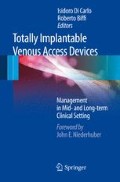Abstract
Pocket hematoma is an acute, relatively common complication that may occur after totally implantable venous access device (TIVAD) with an incidence ranging between 0% and 4.5%. A hematoma is assumed to be present if there is any palpable swelling of the TIVAD pocket exceeding the size of the device. The causes of the port hematoma may be intraoperative or postoperative. Intraoperative causes may be the consequence of a defective technique. Postoperative causes may also be the pharmacological therapy. In the event of hematoma the use of the port should be delayed until resorption in order to avoid the risk of infection. In case of doubt, this complication should be sonographically confirmed.
Access this chapter
Tax calculation will be finalised at checkout
Purchases are for personal use only
References
Pavia S, Wilkoff B (2001) The management of surgical complications of pacemaker and implantable cardioverter-defibrillators. Curr Opin Cardiol 16:66–71
Ku YH, Kuo PH, Tsai YF et al (2009) Port-a-cath implantation using percutaneous puncture without guidance. Ann Surg Oncol 16:729–734
Vardy J, Engelhardt K, Cox K et al (2004) Long-term outcome of radiological-guided insertion of implanted central venous access port devices (CVAPD) for the delivery of chemotherapy in cancer patients: institutional experience and review of the literature. Br J Cancer 91:1045–1049
Di Carlo I, Pulvirenti E, Mannino M, Toro A (2010) Increased use of percutaneous technique for totally implantable venous access devices. Is it real progress? A 27-year comprehensive review on early complications. Ann Surg Oncol 17:1649–1656
Sakamoto N, Arai Y, Takeuchi Y et al (2010) Ultrasound-guided radiological placement of central venous port via the subclavian vein: a retrospective analysis of 500 cases at a single institute. Cardiovasc Intervent Radiol 33:989–994
Kurul S, Saip P, Aydin T (2002) Totally implantable venous-access ports: local problems and extravasation injury. Lancet Oncol 3:684–691
Asch MR (2001) Venous access: options, approaches and issues. Can Assoc Radiol J 52:153–164
Gray RR, Sadler DJ, Shulman L et al (1999) Should anticoagulant therapy be stopped or reversed before venous intervention? Can Assoc Radiol J 50:306–309
Michaud GF, Pelosi FJ, Noble MD et al (2000) A randomized trial comparing heparin initiation 6h or 24 h after pacemaker or defibrillator implantation. J Am Coll Cardiol 35:1915–1918
Belott P, Reynolds D (2000) Permanent pacemaker and implantable cardioverter defibrillator implantation. In: Ellenboggen K, Kay G, Wilkoff B (eds) Clinical cardiac pacing and defibrillation. WB Saunders, Philadelphia, pp 573–644
Rouzrokh M, Shamsian BS, Tabari AKN et al (2009) Totally implantable subpectoral vs. subcutaneous port systems in children with malignant diseases. Arch Iranian Med 12:389–394
Knebel P, Fischer L, Cremonese E et al (2008) Protocol of an expertise based randomized trial comparing surgical venae section versus radiological puncture of vena subclavia for insertion of totally implantable access port in oncological patients. Trials 9:60
Poorter RL, Lauw FN, Bemelman WA et al (1996) Complications of an implantable venous access device (port a cath) during intermittent continuous infusion of chemotherapy. Eur J Cancer 32:2262–2266
Wiegand UKH, LeJeune D, Boguschewski F et al (2004) Pocket haematoma after pacemaker or implantable cardioverter defibrillator surgery: influence of patient morbidity, operation strategy, and perioperative antiplatelet/anticoagulation therapy. Chest 126:1177–1186
Author information
Authors and Affiliations
Corresponding author
Editor information
Editors and Affiliations
Rights and permissions
Copyright information
© 2012 Springer-Verlag Italia
About this chapter
Cite this chapter
Toro, A., Di Carlo, I. (2012). Pocket Hematoma. In: Di Carlo, I., Biffi, R. (eds) Totally Implantable Venous Access Devices. Springer, Milano. https://doi.org/10.1007/978-88-470-2373-4_19
Download citation
DOI: https://doi.org/10.1007/978-88-470-2373-4_19
Publisher Name: Springer, Milano
Print ISBN: 978-88-470-2372-7
Online ISBN: 978-88-470-2373-4
eBook Packages: MedicineMedicine (R0)

